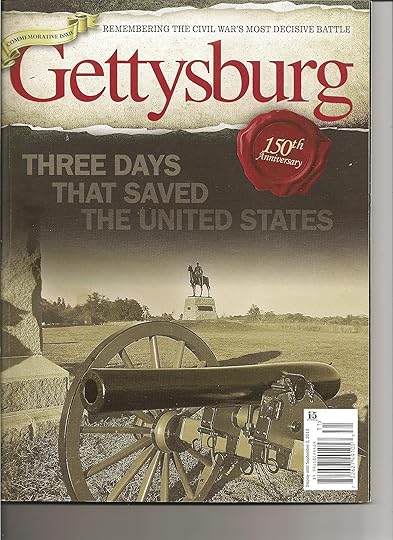Gettysburg: Three Days that Saved the United States
 This July marks the 150th anniversary of the
This July marks the 150th anniversary of theBattle of Gettysburg. The battle holds special significance in the history of
the American Civil War. Not only was it the bloodiest battle of the war,
creating some 51,000 casualties over three days of fighting, it was also what
historians call the turning point of the war.
The fighting that occurred at Gettysburg on July 1-3, 1863
marks the closest the Confederacy got to ending the war, if not with a rebel
victory then with a negotiated peace. Following its defeat at the Pennsylvania
crossroads town, followed one day later by the Union victory at Vicksburg, the
Confederacy was never able to take the offensive again. The civil war would
last nearly two more years, but the die was cast at Gettysburg — the Union
would be preserved.
My latest nonfiction writing project was to contribute a
piece to I-5 Publishing’s recently released commemorative book, Gettysburg: Three Days that Saved the United
States, a pictorial tribute to the soldiers of both sides who fought and
died in that battle.
The high-gloss Gettysburg
takes the reader through those three terrible days of summer, exploring little
known aspects of the fighting. There’s Father Corby, chaplain for the famed
Irish Brigade, who stood amid the bullets and shrapnel to perform a general
absolution. There’s the story of the unknown soldier found dead, a photograph
of his of his children clutched in his hand, and how his identity was finally
determined. And then there’s the story of healing 50 years later when veterans
of both sides of the battle came together for a reunion.
My own contribution is a piece on how Union and Confederate
surgeons treated the terrible wounds created by the new technologies of war.
Gettysburg: Three Days
that Saved the United States is available most major retailers and book
stores.ually remember the titles and the fact I’ve read them. So I didn’t think it bode well for Deep Storm when I started reading it without remembering I had already read it years before. Was it really that forgettable?
No, not forgettable at all. I may not have remembered the title, but I definitely remembered the plot—and it’s a pretty good one.
Dr. Peter Crane is a former U.S. Navy physician with highly respected background in undersea medicine. Therefore, he was not surprised when he was summoned to an oil platform in the North Atlantic to diagnose a strange medical condition spreading through the rig’s crew. Once he arrives, however, Crane discovers the medical condition isn’t affecting the platform’s crew but the crew of a massive underwater facility two miles below the rig. Once sworn to secrecy, Crane is told the submerged facility, called Deep Storm, is excavating an ancient site that may be the remains of the ancient lost civilization Atlantis.
Crane descends to Deep Storm, but as he struggles to discover the source of the strange malady affecting the crew, he begins to suspect there is something far more sinister about the archeological dig than the answer to an ancient myth.
Deep Storm’s plotting is suspenseful and compelling. My only complaint with the book is that Child repeatedly used “sailor,” “Marine,” and “soldier” as if the terms were interchangeable. That’s a real good way to start a bar fight.



